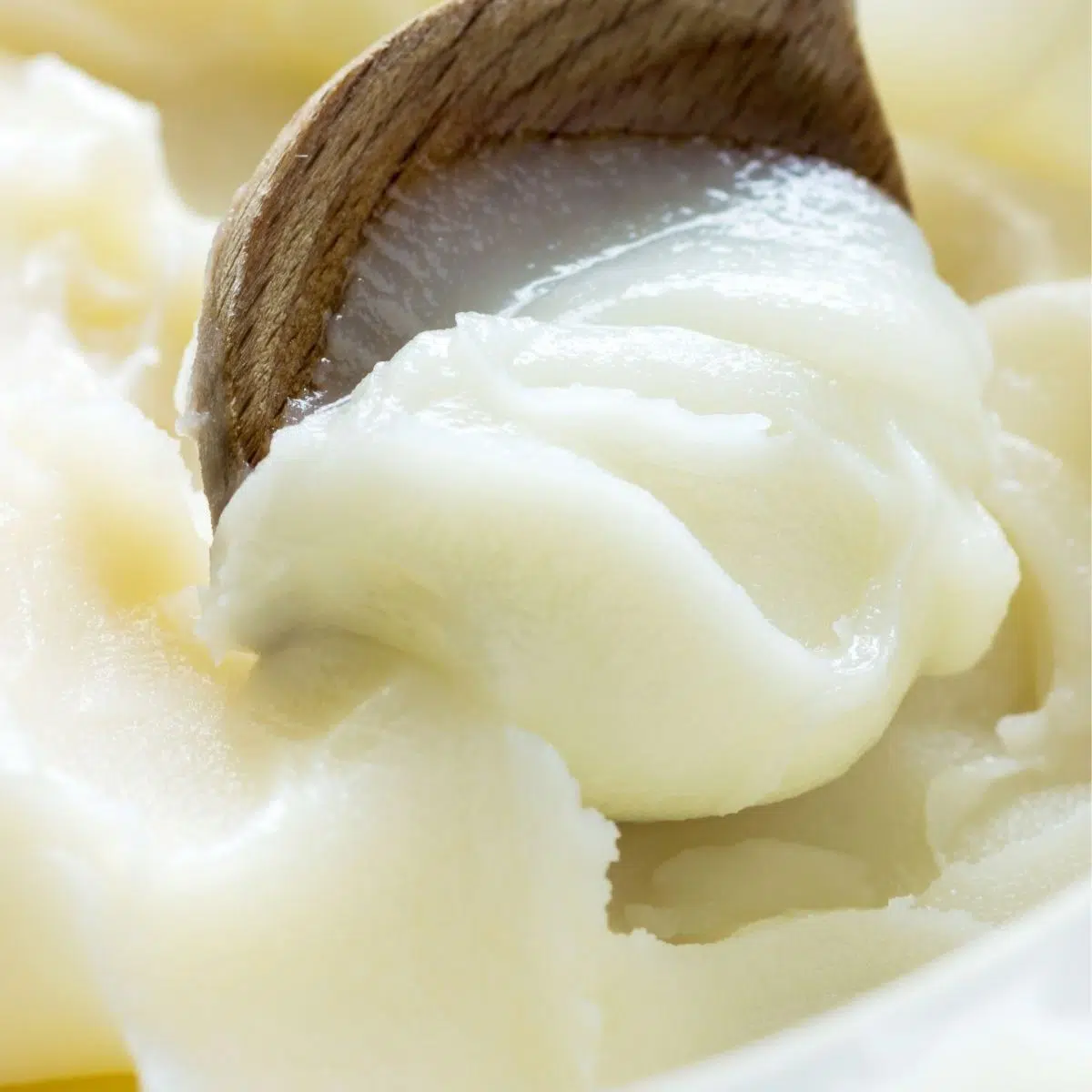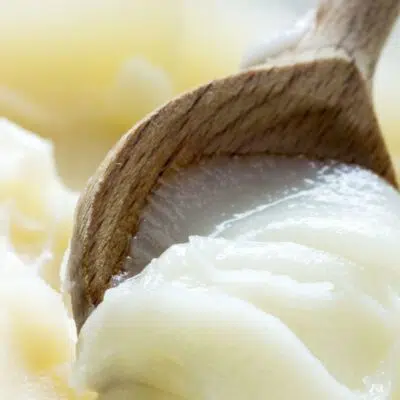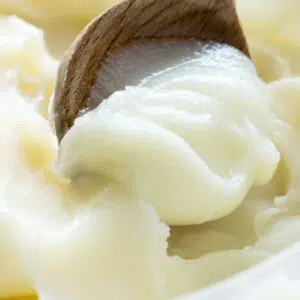Finding a lard substitute is as easy as choosing one of these common ingredients (some of which you might have at home)! There are so many delicious fatty alternatives that you'll never have to use lard when cooking or baking again if that's what you prefer!

Some amazingly simple ingredients that can replace lard in any recipe!
Back in the day, lard was the go-to for fat in cooking and baking. While it is not as commonly used in day-to-day cooking now, there are still several recipes that call for lard.
You may find that you have an old recipe from your grandma that calls for lard, or you found a vintage cookbook. Even though lard was popular when these recipes came out, some people today find the idea of using lard less than appealing.
Jump to:
The great thing about recipes that call for lard though is that there are several amazing substitutes! Many of which you probably already have in your kitchen.
What Is Lard?
Anytime you are looking for a substitute it is always helpful to know exactly what it is you are substituting for. Therefore, even if you don't want to use lard, knowing what it is will be helpful.
Lard is fat that comes from a pig. Moreover, it is fat that has been rendered. This means that the fat removed from the pig was melted down to separate the fat from the water and proteins.
The rendering process is essential when making lard because it leaves you with only the fat solids. This is the bright white solid fat that is sold in stores.
Without the proteins and waters, lard will not easily spoil. This is one reason why it was so popular throughout history - it had a long shelf life. This also means that lard is 100% fat (it does not contain any water or protein).
What is Lard Used For?
Another reason lard was popular is because it is so versatile. The neutral taste and high fat content of lard makes it a great choice for both cooking and baking.
Lard can be melted down and used the same way other fats (oil, butter) are used to sauté or grill, as well as deep frying. In baking, it works well in most recipes. With its high fat content, it is especially great for producing flaky biscuits and pie crusts.
Why is Lard Not Used as Much Anymore?
Even though lard is quite easy to find (it is in the baking aisle of the grocery store), it often gets overlooked for other fats like vegetable oil, shortening, and butter. Much of this is due to the push to use shortening when it was invented in the early 20th century.
The invention of shortening offered a new fat that had a similar shelf life and was made from vegetable oil, rather than animal fat. Since then, lard has been used less frequently in home kitchens.
Therefore, people are not as familiar or comfortable using it.
While lard is not used in home kitchens in America as much anymore, it is still commonly used around the world. Many chefs also choose to use this fat in their kitchens.
The Best Substitutes for Lard in Cooking and Baking
Most of the substitutes for lard can be used in both cooking and baking. However, some will work better than others.
For example, vegetable oil and shortening are better for frying (since they have a high smoke point), while mashed avocado and banana are only suitable for baking. Other substitutes will also be better for different people, for example, if you want a vegan option.
Whatever your need or desire for a substitute though, at least one of these 10 best substitutes will be perfect!
1. Shortening
As the replacement for lard in many recipes in the early 20th century, shortening is one of the best substitutes for lard in both baking and cooking. Made from hydrogenated vegetable oil rather than animal fat, it also suitable for vegans.
Like lard, shortening is a 100% fat and has a neutral taste. This provides similar results in baked goods. It also has a high smoke point that makes it ideal for frying.
Shortening can be substituted cup for cup in any recipe.
Even though it has a similar fat content as lard, in larger quantities (1 cup for 1 cup) many cooks find that adding 2 extra tablespoons per cup gives the best results in baking.
2. Butter
Butter is one of the easiest substitutes for lard. It can also be used in both baking and cooking.
The two main differences between butter and lard are the fat content and the taste. While lard is a 100% percent fat, butter contains only about 80%. The other 20% of butter is made up of water.
The water content of butter will change the texture of some recipes. In addition, butter has a rich taste that often comes through in baked goods. Most people love this buttery taste, but it's important to note in case a recipe will not be suited to the rich butter flavor.
Due to the lower fat content in butter, you will need to use extra butter to compensate for lard. See the quick conversions here:
- 1 ¼ cup butter = 1 cup of lard
- ½ cup plus 2 tablespoons = ½ cup lard
- ¼ cup plus 1 tablespoon = ¼ cup lard
3. Vegetable Oil (Canola Oil)
Vegetable oil (or canola oil) is a good substitute for lard in many recipes, especially in cooking. With a high smoke point and neutral flavor, it is an easy substitute for sautéing and frying.
Like lard, vegetable oil also has a 100% fat content. However, as a liquid it has some differences in structure when used in baking. For example, cookies will be flatter and crunchier when cooked with oil (compared to lard or butter).
For the best results, use a little bit less oil than you would lard. In cooking, this will not be as important, and you can often use a simple 1:1 exchange. In baking though, aim for ⅞ cup of oil for every 1 cup of lard.
4. Olive Oil
Like vegetable oil, olive oil has a high fat content that resembles lard. However, olive oil has a more distinct taste.
In cooking, the taste of olive oil works well in most recipes. Olive oil does not have the same high smoke point as lard though; therefore, it is not a good choice for frying foods.
While olive oil is not often thought of as a baking fat, it works quite well! You can use olive oil in any baking recipe that calls for lard and it will provide a mild savory taste.
Olive oil can easily be swapped in for lard in an equal 1:1 exchange in both baking and cooking.
5. Coconut oil
Just like other oils, coconut oil has similar properties to lard that makes it a good substitute. More than olive oil, coconut oil's distinct taste is the main thing to consider when using it as a substitute.
The flavor from coconut oil pairs nicely with many sweet desserts. It can also work in certain recipes to sauté meats and vegetables; however, it is not suitable for frying.
Use coconut oil in an even 1:1 exchange for lard.
6. Margarine
Margarine was popular during the diet age of the 1980s, but it is not quite as popular anymore. Like lard though, you will find that many older recipes call for margarine as a fat source.
Even though margarine is used as fat in baking, it has a lower fat content than lard. Therefore, this can be a good choice for those who want a low-fat option. However, due to its lower fat content it will create a denser baked good.
Margarine can also work in cooking, but not frying; however, keep in mind that margarine has a distinct flavor that some may not enjoy.
Use ¾ cup of margarine in place of 1 cup of lard in most recipes.
7. Ghee
Ghee is commonly used in Southeast Asian cooking but has become more common around the world in recent years. It is made in a similar fashion to lard, except with butter.
Butter is boiled down and the fat is separated from the water and milk proteins. This produces a clarified butter that is primarily fat.
Ghee can be used in place of lard in both cooking and baking. It has a high smoke point like lard, which even makes it a good choice for deep frying.
Ghee is a lighter texture than lard, so to get the best results use a little bit more ghee.
Use 1 cup of Ghee plus 2 tablespoons in place of 1 cup of lard.
8. Beef Tallow
Beef tallow is basically the same thing as lard, except it is made from cows rather than pigs. This produces a similar fat that can work well in many recipes.
One big difference between these two animal fats is the taste though. Beef tallow has a distinct meat flavor that is not found in lard. Therefore, it is best to use this substitute for cooking and in dishes that will pair well with the flavor.
Use beef tallow in an equal 1:1 exchange for lard.
9. Avocado
Avocado may seem like an odd replacement for lard, but it in certain baked recipes it can do a great job!
With a high fat content, mashed avocado produces a wonderful rich and creamy texture that can replace the lard in baked goods like quick breads and cookies. Avocado is also great at adapting to other flavors; therefore, it will not greatly impact the taste of your recipe.
Use ½ cup of mashed up avocado for 1 cup of lard in baking. For the best results, blend the avocado in a food processor to make it nice and smooth.
10. Mashed Banana
On the other side of a rich fat replacement like avocado, is a non-fat option: mashed banana.
The texture of mashed banana does a great job of mimicking lard in baking. It helps to bind the ingredients, while also adding moisture. This makes it a good choice for quick breads and cookies.
The main thing to consider when using mashed banana is the distinct banana taste and added sweetness. When using mashed banana, consider leaving out some of the sugar (or other sweetener) that the recipe calls for.
Use ½ cup of mashed banana for 1 cup of lard in baking.
Note on Mashed Fruits:
When using fruit (yup, avocado is a fruit) instead of lard your final baked goods will be denser. This is why these choices work best for quick bread recipes (like banana or zucchini), muffins, or cookies.
Bonus! Number 11 is Bacon Grease!!
Don't forget this staple of many kitchens that is almost identical to lard, making it an ideal substitute for any recipe! Having these two fats on hand means you can make any vintage or old-fashioned recipe in a snap!
I can't believe that I got all the way down to number 8 before mentioning my favorite fat to cook with (and I use grass fed, grass finished tallow). And then, I almost completely finished this informative article without including something that is also ALWAYS IN MY FRIDGE.
Must be that I take both of these for granted as always being readily available. In either case, with either one, they can be used in an equal 1:1 ratio for any recipe that calls for lard. Enjoy!
We wish you luck with your recipe and hope we have helped you find the perfect lard substitute whether you're baking or frying up delightful treats! Let us know what you're making by dropping a comment below!
Do you love a recipe you tried? Please leave a 5-star 🌟rating in the recipe card below and/or a review in the comments section further down the page.
Stay in touch with me through social media @ Pinterest, Facebook, Instagram, or Twitter! Subscribe to the newsletter today (no spam, I promise)! Don't forget to tag me when you try one of my recipes!
📖 Recipe Card
Best Lard Substitutes: Bacon Grease & Coconut Oil (+More Great Alternatives!)
Ingredients
Best All-Around Lard Substitute - Bacon Grease
- 1 tablespoon bacon grease
Best Plant-Based Lard Substitute - Coconut Oil
- 1 tablespoon coconut oil
(Note: 2x or 3x only changes the ingredient list)
Instructions
Best All-Around Lard Substitute - Bacon Grease
- Use bacon grease in an equal amount, a 1:1 ratio as the amount of lard called for in any recipe. This is my preferred substitute for all cooking and frying, and some of my baking recipes.
Best Plant-Based Lard Substitute - Coconut Oil
- Use coconut oil, preferably unrefined virgin coconut oil, in an equal ratio of 1:1 as well. This can also be used in any cooking or baking recipe, but is my favorite for the majority of my vintage baking recipes that call for lard.



Comments
No Comments